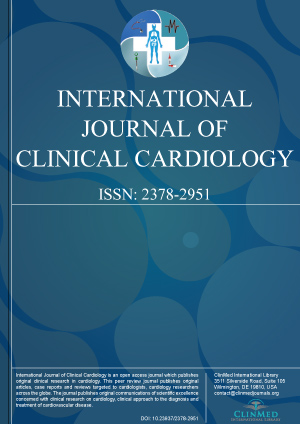Open Access DOI:10.23937/2378-2951/1410030
Influence of MRI-Conditional Cardiac Pacemakers on Quality and Interpretability of Images Acquired in 1.5-T Cardiac MRI
Kenichi Yokoyama, Toshiya Kariyasu, Shigehide Kuhara, Masamichi Imai, Rieko Ishimura and Toshiaki Nitatori
Article Type: Research Article | First Published: April 24, 2015
Purpose: The influence of MRI-conditional cardiac pacemakers on the quality and interpretability of images acquired in cardiac MRI (CMR) examinations was retrospectively investigated. Materials and methods: The subjects in this study were 12 patients (7 men and 5 women, mean age: 68.4 +/- 8.7 years) with MRI-conditional cardiac pacemakers who underwent CMR examinations at our institution between July 2013 and December 2014....
Open Access DOI:10.23937/2378-2951/1410029
An Unlikely Cause of Atrial Fibrillation-Induced Cardiomyopathy: Phentermine, A Diet pill
Sunny-Skye Keppel and Philip Varriale
Article Type: Case Report | First Published: April 19, 2015
We present a case of an unusual cause of atrial fibrillation-induced cardiomyopathy, which is a diet pill, known as phentermine. This medication used for weight loss and can function as a stimulant is intended for short-term use but when taken for an extensive period of time can become a significant risk factor for developing arrhythmias such as atrial fibrillation....
Open Access DOI:10.23937/2378-2951/1410028
Takotsubo Cardiomyopathy Associated with Prolong QT Interval and Ventricular Tachyarrhythmia
Dhavalkumar Patel and Rajendrakumar Patel
Article Type: Case Report | First Published: April 13, 2015
Takotsubo Cardiomyopathy (TCMP), also known as apical ballooning syndrome or stress induced cardiomyopathy, is characterized by left ventricular mid and/or apical wall motion abnormality in the absence of obstructive coronary artery disease. TCMP is a disorder of left ventricular myocardial contractility, and rarely associated with serious cardiac conduction abnormalities....
Open Access DOI:10.23937/2378-2951/1410027
Asymptomatic Left Atrial Appendage Aneurysm
Norliza Othman, Alwi Mohamed Yunus, Raad H. Mohiaddin and Masliza Mahmod
Article Type: Case Report | First Published: April 11, 2015
We report a patient with asymptomatic left atrial appendage aneurysm. Cardiac magnetic resonance was performed to further delineate the aneurysm, and the patient underwent successful surgical resection....
Open Access DOI:10.23937/2378-2951/1410026
Association between Syncope and Myocardial Bridge
Lins TCB, Valente LM, Oliveira KTMN and Brandao SCS
Article Type: Case Report | First Published: April 10, 2015
Myocardial bridge is a cause of sudden death in athletes, but syncope is somewhat related to this disease symptom. This paper reports a case of a young athlete, swimming practitioner with syncopal episodes related to physical exertion....
Open Access DOI:10.23937/2378-2951/1410025
Functional Mitral Regurgitation Tenting Area is Directly Related to Non-Ischemic Cadiomyopathy
Ovidio A. Garcia-Villarreal
Article Type: Letter to the Editor | First Published: March 22, 2015
I have read with great interest the article by Kammoun et al., and I congratulate them for this paper. Functional mitral regurgitation (MR) is a very hard-to-treat illness, because it is not a disease itself but just the final result of an impaired and/or geometrically distorted left ventricle. Agricola et al. have described in a fie way the high impact played by the tethering mechanism of the posterior mitral complex in this kind of patients....
Open Access DOI:10.23937/2378-2951/1410023
Erythropoietin Treatment Improves Peak VO2 and Oxygen Uptake Efficiency Slope without Changing VE vs. VCO2 Slope in Anemic Patients
Ayumi Goda, Haruki Itoh, Yoshiko Ebi, Kumiko Kondo, Tomoko Maeda and Toshitsune Shimada
Article Type: Research Article | First Published: March 20, 2015
The aim of this study was to evaluate the improvement in hemodynamic, metabolic, and ventilatory response during exercise along with the improvement of anemia with EPO treatment in anemic hemodialysis patients. Methods: Thirty-seven hemodialysis patients with anemia (48.8 +/- 13.6 years) received EPO (1500 or 3000 unit, 3 times a week). Parameters measured prospectively before and after EPO treatment included hemoglobin, cardiac output by dye dilution method, echocardiography, and cardiopulmonar...

